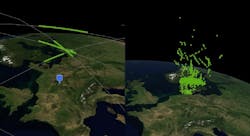GESTRA space radar enters final test phase
MUNICH - The German Experimental Space Surveillance and Tracking Radar (GESTRA), developed and built by the Fraunhofer Institute for High Frequency Physics and Radar Techniques (FHR) on behalf of the German Space Agency at the German Aerospace Center (DLR), began final testing in December 2023 following an intensive and successful test and verification phase. This means that this globally unique space surveillance system has entered its commissioning phase, which will last several months. Together with experts from Fraunhofer FHR, the German Space Agency at DLR carried out tests at the German Space Situational Awareness Centre (GSSAC) reports the German Aerospace Center. Continue reading original article.
The Military & Aerospace Electronics take:
5 January 2024 - DLR says that the complex GESTRA radar system comprises a transmitting and receiving antenna, each equipped with 256 individual elements when fully loaded and whose radar waves can be phase-controlled, also known as a phased array. The transmitting antenna elements are controlled by an extremely powerful amplifier, so the approximately four-meter-long antenna has an immense total output. The elements of the receiving antenna are individually read out digitally and can be combined in real-time using special processor units. This allows the two antennas to change their direction of view to within a few milliseconds.
In addition, the antennas can be mechanically aligned using a rotating stand. A separate water-cooling system for each antenna element also contributes to the particularly high radar performance. This further increases the sensitivity of the system. As a result, GESTRA is not only very dynamic when observing space debris, but also extremely sensitive. The transmitter and receiver are housed in two separate containers, which allows for flexible deployment at different locations. This combination of mobility, digital technology, and performance makes GESTRA unique. The system is installed at the Schmidtenhöhe training area near Koblenz.
Related: LeoLabs unveils Kiwi Space Radar
Jamie Whitney, Senior Editor
Military + Aerospace Electronics
